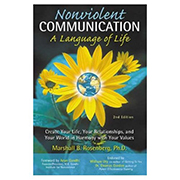Nonviolent Communication (NVC), also called Compassionate Communication, is a communication process developed by Marshall Rosenberg beginning in the 1960s. NVC often functions as a conflict resolution process. It focuses on three aspects of communication: self-empathy (defined as a deep and compassionate awareness of one’s own inner experience), empathy (defined as listening to another with deep compassion), and honest self-expression (defined as expressing oneself authentically in a way that is likely to inspire compassion in others).

I think it is important that people see that spirituality is at the base of Nonviolent Communication, and that they learn the mechanics of the process with that in mind. It’s really a spiritual practice that I am trying to show as a way of life.
Even though we don’t mention this, people get seduced by the practice. Even if they practice this as a mechanical technique, they start to experience things between themselves and other people they weren’t able to experience before. So eventually they come to the spirituality of the process. They begin to see that it’s more than a communication process and realize it’s really
an attempt to manifest a certain spirituality. — Marshall Rosenberg
NVC is based on the idea that all human beings have the capacity for compassion and only resort to violence or behavior that harms others when they don’t recognize more effective strategies for meeting needs. Habits of thinking and speaking that lead to the use of violence (psychological and physical) are learned through culture. NVC theory supposes all human behavior stems from attempts to meet universal human needs and that these needs are never in conflict. Rather, conflict arises when strategies for meeting needs clash. NVC proposes that if people can identify their needs, the needs of others,
and the feelings that surround these needs, harmony can be achieved.
While NVC is ostensibly taught as a process of communication designed to improve compassionate connection to others, it has also been interpreted as a spiritual practice, a set of values, a parenting technique, an educational method and a worldview.


